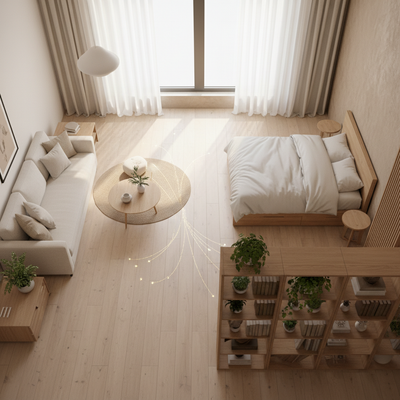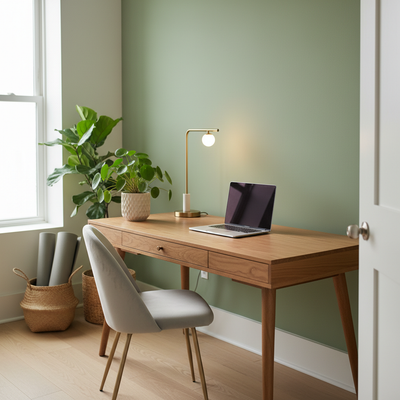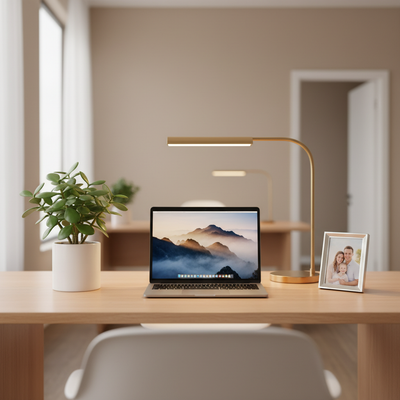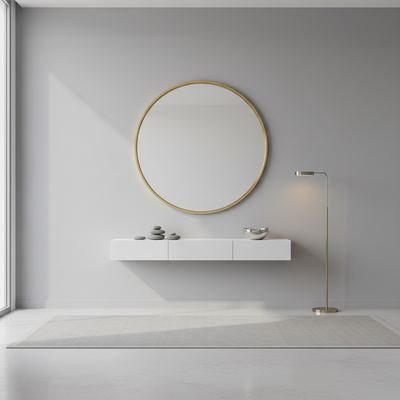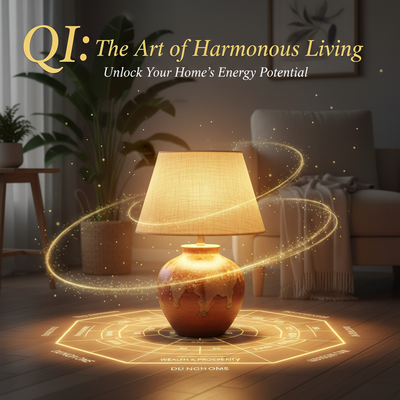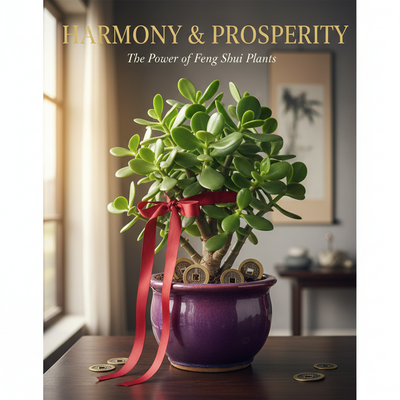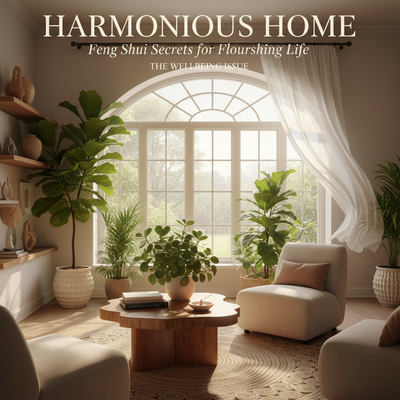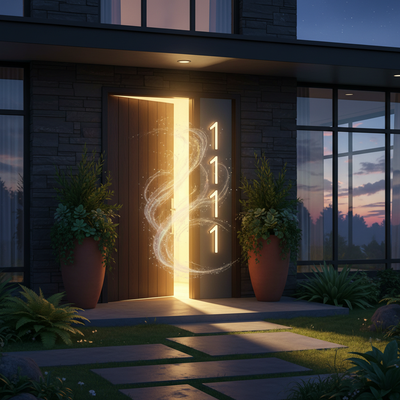Walk into a room painted bright, clean white, and you can almost feel your mind becoming clearer. That instant feeling of freshness, order, and new possibilities isn't just chance. It's the special energy of the color white working. If you want to use this power in your own home, you're in the right place. The main reason for using the feng shui color white is to connect with the energy of the Metal element, which controls purity, focus, and new starts. White acts like a blank canvas, helping you reset a room's energy and bring clarity into your life.
This guide will take you on a complete journey. We will first look at what white means in feng shui, going beyond just how it looks to understand its energy effects. Then, we will give you practical ways to use white smartly with the Bagua map to improve specific parts of your life. You will learn how to use this knowledge in each room of your home, and we will share expert tips for mixing different shades and textures to create beautiful, well-balanced rooms. Finally, we will show you a real example and point out common mistakes to avoid, so you can use white with confidence and purpose.
What White Really Means

To use white well in feng shui, we must first understand its two sides. It is much more than just a plain background color; it is a powerful activator of a specific type of energy, or Qi. In the traditional system of the Five Elements, white is the color of the Metal element. This connection gives it special qualities that affect any space where it's used. It is also mainly a Yin color, promoting stillness and thinking, which must be balanced for a peaceful home.
Purity and New Starts
At its most basic level, white represents a fresh start. It holds the energy of possibility, making it the perfect color for clearing out old, stuck energy and beginning again. Think of the crispness of a new piece of paper or fresh snow. This is the energy white brings into a space. It supports mental and emotional cleaning, encouraging honesty, innocence, and clear thinking. When you feel stuck or overwhelmed by the past, adding white on purpose can help you symbolically start fresh and open the door to new opportunities and a new way of looking at things.
The Metal Element Connection
The Metal element gives white its most important qualities: structure, logic, strength, and attention to detail. Metal energy is precise, organized, and efficient. It cuts through confusion and helps you focus on what is essential. By adding white to your environment, you can improve your own mental clarity, support tasks that need concentration, and create a greater sense of order in your life. This idea comes from the ancient theory of the Five Elements, or Wu Xing. This system explains that Metal is one of five essential energy phases that control all universal interactions. Colors are one of the most direct and real ways we can work with these elemental energies in our personal spaces to create balance and support our goals.
The Yin Side of White
In the Taoist idea of Yin and Yang, white is considered a Yin color. Yin energy is contracting, passive, quiet, and receptive. This makes white an excellent choice for creating spaces that feel calm, peaceful, and thoughtful. It encourages you to slow down, look inward, and find peace. However, this is also why too much white can feel cold, sterile, or lonely. Unlike bright, expanding Yang colors (like red or orange) that promote activity and social interaction, the quiet nature of Yin needs to be balanced. The key is to use white to create a foundation of calm without letting the energy become stuck or uncomfortably harsh.
White and the Bagua Map
One of the most powerful tools in feng shui is the Bagua map, an energy grid that you can place over your home's floor plan. Each of the nine sections, or "guas," matches a specific area of your life, an element, and certain colors. By smartly placing the color white in the correct Bagua areas, you can activate and improve these parts of your life. White is most powerful in the two areas controlled by the Metal element.
Activating Creativity (Dui ☱)
The Dui gua is connected with Children and Creativity. Its element is Metal, and its location is in the West part of your home. This area controls joy, self-expression, creative projects, and the well-being of any children in the household. Using white here is a powerful way to encourage fresh ideas and clear any energy blocks to your creative flow. It creates an atmosphere of pure potential, like an empty canvas waiting for the first paint stroke. To activate this area, consider creating a gallery wall with clean white frames, placing a white sculpture, or organizing creative supplies in white containers. For children, a play area with white furniture can encourage a sense of joyful, uncluttered fun.
Attracting Helpful People (Qian ☰)
The Qian gua is connected with Helpful People and Travel. Its element is also Metal, and its location is in the Northwest part of your home. This area relates to attracting mentors, supportive friends, influential contacts, and beneficial opportunities, as well as making travel smooth and meaningful. White in the Northwest strengthens the Metal energy here, signaling to the universe that you are open and ready to receive guidance and support. It improves your ability to connect with the right people at the right time. Practical ways to use this include painting the Northwest wall a crisp white, adding white decorative objects (especially those made of metal), or displaying photos from travels or images of people you admire in silver or white frames.
| Bagua Area | Location | Element | Life Goal | How to Use White |
|---|---|---|---|---|
| Creativity & Children | West | Metal | Joy, creative projects, children's luck | White accents, furniture, art, gallery walls |
| Helpful People & Travel | Northwest | Metal | Mentors, support, new opportunities | White walls, metallic white objects, frames |
A Room-by-Room Guide
Turning feng shui theory into practical design is where real change happens. Each room in a home has a unique purpose and energy, and using white should be customized accordingly. Here is a guide to using white effectively in the key areas of your home, complete with goals, specific recommendations, and important considerations.
White in The Kitchen
The goal for using white in the kitchen is to improve the sense of cleanliness, freshness, and precision in the space where we prepare food to nourish ourselves and our families. The Metal element's qualities of cleanliness and order are perfectly suited to this room.
- Do's:
- White countertops, such as quartz or marble, create a clean and long-lasting surface for food preparation.
- White cabinets can make a kitchen feel larger, brighter, and perfectly clean.
- A white tile backsplash is timeless and strengthens the energy of purity.
- Considerations:
- An all-white kitchen can feel cold. It's important to balance the Metal energy. Add the Wood element with a butcher block island, wooden cutting boards, or fresh herbs in pots. Add the Earth element through ceramic bowls, pottery, or warm-toned flooring to ground the space and make it feel more welcoming.
White in The Bathroom
The goal in the bathroom is to create a clean, crisp, and spa-like atmosphere that promotes the energy of cleansing and release. As a space dedicated to washing away the day, the purity of white is a natural and powerful choice.
- Do's:
- Fluffy white towels and bathmats immediately create a sense of spa-like luxury and cleanliness.
- White fixtures, such as the sink, toilet, and bathtub, are a classic choice that supports the room's function.
- White tiles on the walls or floor can make a small bathroom feel more open and airy.
- Considerations:
- Lighting is critical in a white bathroom. Poor or harsh lighting can make the space feel clinical and unwelcoming. Make sure you have warm, layered lighting. To prevent the energy from becoming too sterile, add a touch of vibrant life energy with a live plant, like an orchid or a snake plant, which grows well in humid conditions.
White in The Living Room
The goal in the living room is to use white to create a bright, open, and flexible backdrop for family life, relaxation, and social gatherings. It can serve as a canvas that promotes clarity and allows other elements in the room to stand out.
- Do's:
- Use a soft off-white as a main wall color to create a peaceful and flexible foundation that works with any decor style.
- Add white shelving to display meaningful objects, books, and art, allowing their colors and forms to take center stage.
- Considerations:
- A living room that is only white can feel stark and formal, discouraging relaxation and comfort. This is a key area for layering. Use a variety of textures in your white elements—a bouclé sofa, a linen curtain, a wool rug—and bring in accent colors and natural materials through pillows, throws, plants, and wood furniture to create a balanced and inviting atmosphere.
White in The Bedroom
The goal for using white in the bedroom is to promote peace and cleanliness without creating a stark, mentally active energy that disrupts rest. This is the room where a careful approach to white is most important.
- Why the Caution?: The bedroom is a Yin space dedicated to deep rest and renewal. Bright, stark white carries the sharp, focused energy of the Metal element, which can be too mentally stimulating for sleep. It can keep your mind "on," making it difficult to unwind.
- Do's:
- Instead of bright white, choose softer shades like cream, ivory, or very light beige. These tones contain a hint of the Earth element, making them feel more nurturing and grounding.
- Use crisp white for bed linens. They symbolize cleanliness and are easy to wash, allowing you to regularly refresh the energy of your bed.
- Considerations:

Layering Different Shades and Textures
One of the most common mistakes people make is treating "white" as a single, uniform color. This often leads to spaces that feel flat, cold, and sterile. The secret to a sophisticated and energetically balanced white interior lies in understanding the range of white and mastering the art of layering texture. This approach moves you from a basic application to a designer-level execution that is both visually stunning and deeply comforting.
The Range of White
"White" is a family of colors, each with its own subtle undertone and energetic quality. Choosing the right shade is important for setting the desired mood in a room.
- Bright White: This is pure white with no visible undertones. It has a high-energy, crisp, and modern feel. Because of its intensity, it's best used for accents that you want to stand out, like trim, doors, or in spaces that require sharp focus, like a home office.
- Off-White/Ivory: These warmer whites contain subtle hints of yellow, brown, or beige. This addition of the Earth element makes them feel more grounding, nurturing, and inviting. They are an excellent choice for main wall colors in living rooms and bedrooms, creating a soft, gentle glow.
- Cool Whites: These whites have undertones of grey, blue, or even green. They create a more tranquil, peaceful, and formal feeling. A cool white can be beautiful in a bathroom to enhance the watery, spa-like atmosphere or in a sunny room to temper the bright light.
The Power of Texture
Texture is the single most important element for preventing a white room from feeling one-dimensional. It adds visual weight, depth, and a tactile quality that invites you to touch and experience the space. Each texture you add contributes its own layer of energy, creating a rich and complex environment.
- Soft Fabrics: Add a variety of fabrics to soften the crispness of white. Think of bouclé chairs, chunky knit wool blankets, plush velvet pillows, and flowing linen curtains. These elements add comfort and a sense of coziness.
- Natural Wood: Wood provides a vital connection to the Wood element, which brings energy of growth, vitality, and warmth. Contrast white walls with light oak floors, a raw-edge wood coffee table, or walnut shelving to ground the space and add organic beauty.
- Polished & Brushed Metals: Since white is the color of the Metal element, pairing it with actual metal is a natural fit. The key is to vary the finish. A polished brass lamp adds a touch of warm glamour, while brushed chrome fixtures provide a sleek, modern feel. Black iron details can create a strong, grounding contrast.
- Living Plants: Live plants are essential in a white room. They add the vibrant Wood element, organic shapes, and a splash of life-giving color. A tall fiddle-leaf fig in a corner or a collection of small succulents on a shelf can prevent the space from feeling static.
Case Study: A QI FLOW Approach
To show how these principles come together, let's walk through a project that demonstrates the transformative power of white when applied with intention. This mini case study shows how we address a common client problem and use a layered approach to achieve a real-world result.
The Challenge: Office Clarity
We were approached by a client who felt uninspired and unproductive in her home office. The space was furnished with heavy, dark wood furniture from a previous home, the lighting was poor, and clutter had accumulated on every surface. The energy felt stuck and oppressive. Her goal was to create a workspace that felt clear, focused, and motivating—a perfect application for the Metal element's energy.
The Solution: Strategic White
At THE QI FLOW, our first step is always to understand the client's personal goals and the existing energy of the space. For this project, our team recommended a multi-layered approach to the feng shui color white to bring in the Metal element's clarity without creating a cold or sterile environment.
- Step 1: The Foundation. We started by painting the walls a soft, warm off-white. We deliberately avoided a stark, brilliant white, which could have felt too harsh and clinical for long hours of work. This creamy shade provided a bright, airy foundation that felt more nurturing and supportive.
- Step 2: The Focal Point. The heavy, dark desk was replaced with a sleek, minimalist white desk. This immediately became the "command center" of the room, establishing a clean, organized surface that energetically encouraged focus and efficiency.
- Step 3: The Accents. To make the client's accomplishments and resources "pop," we installed brilliant white floating shelves. We also added silver (a metallic form of white) picture frames in the Northwest corner of the office to consciously activate the "Helpful People" area of the Bagua, inviting mentors and beneficial connections into her professional life.
- Step 4: The Balance. To ground all the new Metal energy, we added crucial balancing elements. A plush wool rug in a natural oat color added texture and Earth energy underfoot. We also placed several large, leafy green plants to bring in the vibrant, upward-moving energy of the Wood element, fostering growth and creativity.
The Result: Productivity Hub
The transformation was amazing. The final space was bright, airy, and felt twice as large. It became a hub of productivity and inspiration that the client loved spending time in. The strategic use of different shades of white, combined with balancing textures and elements, created an environment that was both highly organized and deeply inspiring. The client reported a significant increase in focus, a renewed passion for her work, and a greater sense of possibility.
Common Mistakes with White
While white is a versatile and powerful color in feng shui, it's easy to make mistakes that can undermine your intentions. Being aware of these common pitfalls will help you use white correctly and confidently, avoiding the creation of a space that feels energetically off-balance.
- The "Hospital" Effect
- The Problem: Overusing brilliant, sterile white on every surface—walls, floors, and furniture—without any variation. This creates a cold, stark, and unwelcoming energy that can feel barren and isolating.
- The Solution: Always balance white with other elements. Add a rich variety of textures, introduce the warmth of natural materials like wood and stone, and use a range of white shades, from warm creams to cool greys.
- Ignoring the Bedroom's Needs
- The Problem: Applying the same "bright and clean" logic to the bedroom, using large amounts of brilliant white on the walls. This introduces an active, mental energy into a space that requires passive, restful energy.
- The Solution: Prioritize rest. Choose soft creams, ivories, and other nurturing off-whites for walls. Use pure, crisp white mainly for bed linens, which can be easily and regularly cleaned.
- Forgetting to Clean
- The Problem: White shows dust, dirt, and scuffs more than any other color. In feng shui, physical dirt and clutter represent stuck Qi (energy), which cancels out the positive, purifying qualities of the color.
- The Solution: Commit to the upkeep. Using white is a commitment to cleanliness. Regularly wipe down surfaces and keep the space tidy to maintain the clear, fresh energy you intended to create.
- Missing the Bagua Opportunity
- The Problem: Painting a wall white randomly without considering its location within the home's energy map. While it may still brighten the space, you miss out on the targeted benefits.
- The Solution: Refer back to the Bagua map. Use white with intention in the West (Creativity & Children) and Northwest (Helpful People & Travel) areas to specifically amplify the Metal element where it is most beneficial.
Conclusion: Using White with Purpose
White is far more than a safe or neutral choice in design; it is a powerful feng shui tool for creating purity, clarity, and new beginnings. By understanding its connection to the Metal element, you can use it to create spaces that feel not only clean and bright but also organized, focused, and full of potential. The key to success lies in purposeful application. Remember to balance its cool, Yin nature with the warmth of texture and natural materials. Use the Bagua map to place it strategically where it can best support your life goals, and choose your shades wisely to create the precise mood you desire. Armed with this knowledge, you can now embrace the power of white and begin to paint a brighter, clearer, and more intentional canvas for your life.
